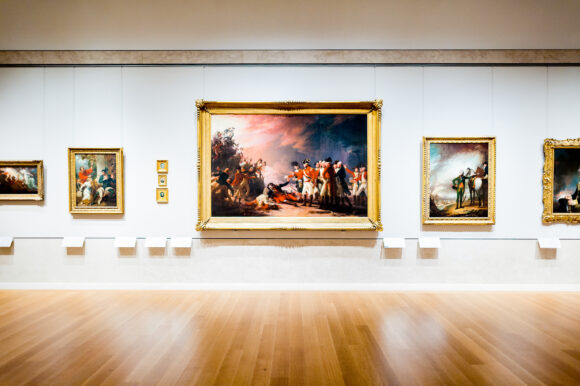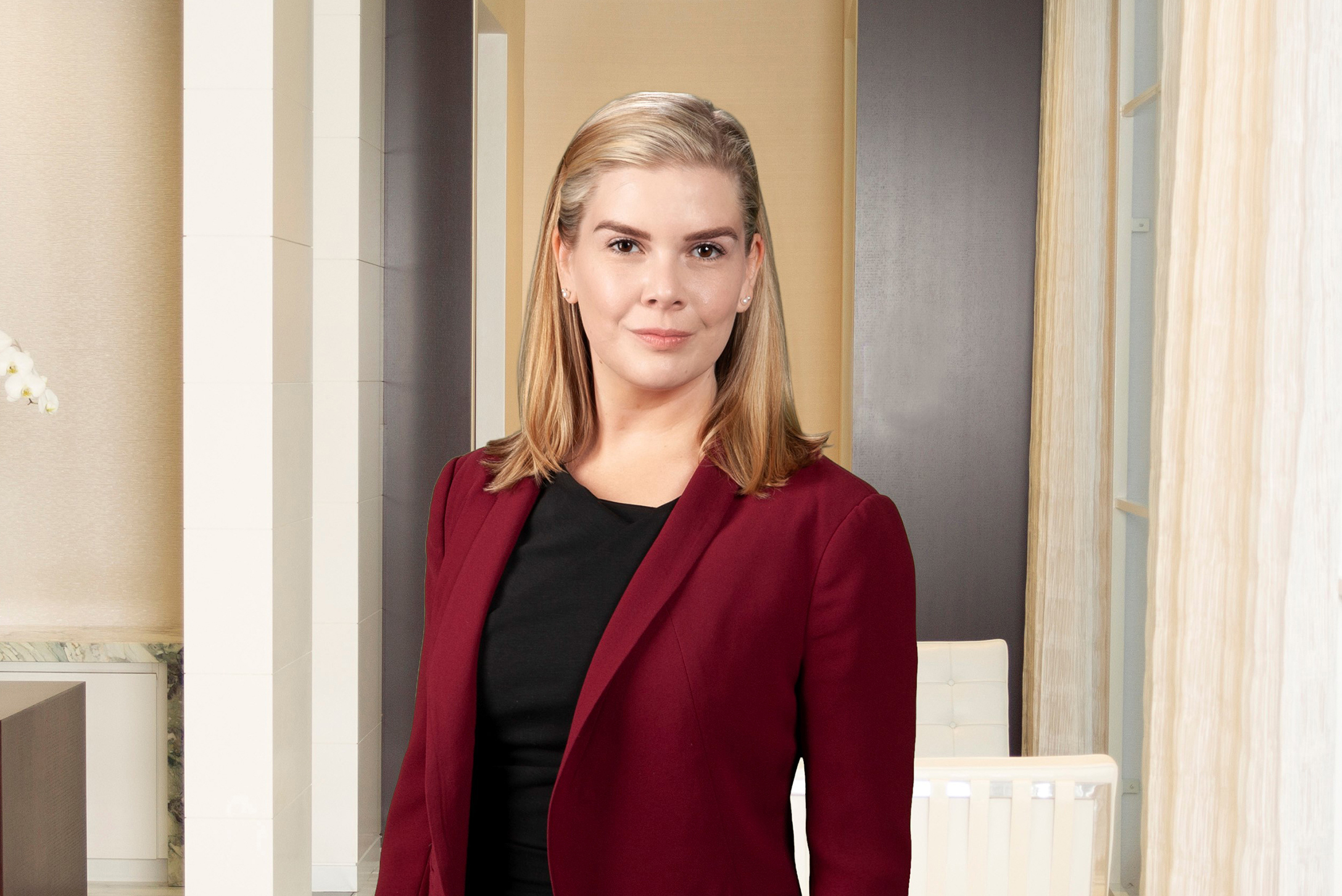Hardly a day passes without reports of another shattered climate record. As Earth’s climate changes, heat waves, floods, droughts, wildfires, and hurricanes are all becoming more frequent and more intense, according to the National Oceanic and Atmospheric Administration (NOAA). And art is uniquely vulnerable to extreme weather events.
While art is an aesthetic, valuable investment — half of high-net-worth individuals have at least 10% of their portfolio in art — it is also subject to risks that other asset classes are not. Art must be kept in precise conditions to maintain value. Heat and humidity can threaten its integrity. And if a weather emergency occurs, such as a hurricane, owners may not have enough time to transport fragile pieces from the epicenter of danger. Compounding the problem, some of the most valuable art is concentrated in areas that are regularly classified as high-risk by insurers, including New York, Los Angeles and Miami.
In the face of these risks, owners and handlers of art can — and should — protect their investments. Protective environments and evacuation plans give solace, but insurance remains the greatest risk mitigation tool to redeem value even if the art itself is damaged or destroyed. The key to maximizing coverage is advanced planning. Anyone concerned about damage to art should consult their insurance policies to determine what coverages they have and, if necessary, obtain additional policies to patch any coverage gaps.
Art Is a Valuable, But Vulnerable, Investment
Art is an important piece of many investment portfolios. In the past 25 years, contemporary art has outperformed the S&P 500 by around three times. Between 2021 and 2022, art increased 29% in value, according to a report from Knight Frank. There is little correlation between the value of art and other asset classes, so art is a worthwhile counterweight to other assets that rise and fall in lockstep. Art maintains its value even in economic downswings because its value is independent of the stock market, making it “currency neutral.”
For example, during the first seven months of 2020, when many investments entered freefall, art outperformed 10 major asset classes, including hedge funds and real estate.
Art, as an asset, has other benefits. About half of all art is sold in private sales. Unlike public sales, private sales do not publish prices, giving investors a layer of privacy. More and more art is available for purchase online, making investment easier than ever and likely contributing to the 187% increase in buyers under 40 years old. And unlike most assets, artworks — physical, tangible objects — can be enjoyed in the investor’s home or displayed for clients. So it is no surprise that around half of high-net-worth investors have at least 10% of their portfolio in art.
While uniquely valuable, art is also uniquely susceptible to other risks. Some of these risks — forgery, clouds on title, damage in transit — will always exist. Paintings loaned to museums may be dropped, drawings smudged, objects d’art lost or stolen. Unanticipated risks arise, too. Think of the climate change activists who have attacked art on display to bring attention to their cause.
In fact, some believe that one of the greatest risks to art is climactic. Because many artworks (particularly paintings) must be kept at precise temperatures and moisture levels to avoid damage, heat waves or cold snaps challenge these conditions, especially if power goes out. Water intrusion also poses a significant threat to art, even to less vulnerable pieces like sculptures. If a sudden weather disaster occurs, it may be impossible to move art in time to avoid damage. Even events with advance warning, like hurricanes, may not provide enough time.
Government organizations like the United States Geological Survey warn that coastal areas are particularly risky for weather events, and art is often concentrated in these areas: New York, Los Angeles and Miami, among them. Hurricane Sandy, for example, caused $200-300 million in losses to art. And those risks are reportedly increasing. NOAA reported that in July 2023 the average global surface temperature was about 2°F above average, making it the hottest month on record. Rising temperatures also affect ocean warming, the effects of which may include intensified hurricanes, according to NOAA. Weather events like these threaten to disturb the fragile equilibrium in which art is least vulnerable to damage.
Protecting Against Damage to Art
Based on these warnings, art collectors are evaluating options to safeguard their investments. These efforts fall within two categories: (1) protecting art from physical loss or damage and (2) recovering the value of damaged art. Both require advanced planning.
The first strategy relies on evacuating and storing art away from high-risk areas when disaster strikes. Many art collectors develop relationships with storage and transportation companies that provide services in anticipation of severe weather. Some storage facilities achieve Global Risk Art Survey Program (GRASP) certification to demonstrate their knowledge and commitment to safeguarding art. Other services may include subterranean storage and redundant HVAC and moisture control systems in event of an outage. But of course, in those instances many investors may evacuate their art at the same time, straining service providers.
Collectors can also disaster-proof their homes. For example, they can install wind- and impact-resistant glass in rooms where art is displayed or stored. Outdoor sculptures can be brought inside during heavy rain or snow to protect them from damage. Backup generators are another good solution to maintain temperature and humidity levels (fuel should be stockpiled in advance). And if art must be evacuated, there should be a clear plan of action, including access points.
The second strategy relies on insurance. Insurance might be the greatest tool to mitigate risks to art, at least from a value perspective: even if physical artwork is damaged or destroyed, collectors have a good chance of recovering their investment. Insurers may also offer tools to prevent damage in the first place. For example, many property insurers offer weather-monitoring services so that collectors are alerted to impending risks.
At the forefront of collectors’ minds is physical loss or damage to artwork. Art can be damaged by weather events while on display, in transit, or in storage. “All-risk” property insurance policies are the first line of defense against loss in value caused by physical harm to artwork. As the name suggests, all-risk policies cover “all risks” to physical property — here, art — unless they are specifically excluded. These policies are typically the first to respond to a loss. Depending on the insuring agreement, they may cover property residing in a specific location, or property in transit. Specific transit insurance, including postal insurance, may patch gaps in coverage for art moving between locations.
Personal property or homeowners’ insurance, subsets of all-risk policies, may also be available. These policies typically require property exceeding a certain value (e.g., $10,000) to be specifically appraised and described in a schedule to be covered. Unscheduled, less-valuable property may be covered without appearing on the schedule. But it’s important to note that many personal property policies exclude unscheduled property “pertaining to a business,” which may exclude art displayed in an office or a client’s home.
Collectors may be able to recoup their investment from other people’s insurance: first- or third-party. Art transported to or displayed in a museum may be protected by first-party “wall-to-wall” exhibition property insurance. Wall to wall coverage often protects art not only while being exhibited, but also in transit. For example, UCLA’s fine arts “wall to wall” coverage protects artwork loaned to UCLA from the time it is removed from its original location, while in transit, and until it is returned to the loaner and including display time. Event cancellation insurance protects art professionals such as museums and galleries from costs associated with exhibitions, tours, and other displays of art that must be canceled because of severe weather. Art collectors may be added as additional insureds to these policies.
Third-party insurance is another avenue for recovery. If art loaned or entrusted to another party is damaged, the owner may choose to file a lawsuit against that party to recover their losses. These other parties should have third-party insurance, which protects against claims by owners for damage to art while providing services. Commercial general liability (CGL) insurance covers defense (attorneys’ fees) and indemnity (payment to compensate for loss) costs for third-party claims. For example, if a collector loans a painting to a museum, the museum’s curator drops the painting and the collector sues, CGL insurance will cover the museum’s costs to defend itself in the lawsuit and to reimburse the collector for damage the curator did to the painting.
Other types of third-party insurance include professional liability insurance, which pays out for third-party claims arising out of the wrongful acts of management and employees (such as conservators) in providing services (such as mishandling art). Museums, foundations and any nonprofit with a board of directors may also have directors and officers (D&O) insurance, which pays out third-party claims arising out of upper management’s violations of duty (such as the duty of due diligence).
Finally, art collectors worried about protecting their investments should consider obtaining insurance to protect against other threats. While this article focuses on mitigating risks increased by climate change, art’s value is vulnerable to several unique risks, particularly clouds on title. Title to art can be harmed by unclear provenance (proof of ownership), as well as theft (historical, for example, Nazi art theft, and contemporary smash-and-grab), forgery and improper import/export. Title insurance may mitigate these risks. Cyber insurance may also be valuable, particularly for collectors of non-fungible tokens (NFTs) and art professionals who store donor information.
Issues in Obtaining Insurance Coverage for Damage to Art
As insurers track climate change risks, they are tightening the screws. Policies protecting against risks arising out of climate change are becoming more expensive while providing less coverage. Art insurance policies traditionally had no deductibles, but deductibles are becoming common in high-risk areas: up to 5-10% of the art’s value. Policies may include exclusions for damage done by wildfire, floods, or earthquakes, which could exclude art located in many high-risk areas from coverage. Since transit claims tend to be the largest area of claims for damage, transit coverage is also facing new coverage restrictions. And as many readers know, some insurers are refusing to write new coverage for property located in areas insurers consider high-risk, like California and Florida.
These new restrictions make it more important than ever to carefully read, and negotiate, policy terms. Here are some of the key provisions to look out for when evaluating an art insurance policy.
Deductibles. The deductible states how much the insured must pay before payment is due under the policy. There may be different deductibles for different risks. Deductibles may be a lump sum ($50,000) or a percentage of value (5% of the value of an art collection). Which deductible applies, particularly if multiple accidents caused a loss, may be critical.
Exclusions for damage caused by weather-related events: fire, floods, hurricanes, wind-driven rain, etc. When buying a policy, investors should determine whether any weather-related risks will be excluded from coverage. Exclusions are often found in endorsements appended to the end of a policy. While these exclusions may be negotiable, it may not make fiscal sense for the insured to pay what insurers want to remove the exclusion. Also important is how those risks are defined. For example, a policy that excludes “wildfires” may still cover damage caused by smoke.
Anti-concurrent Causation Clauses. Consider this scenario: an art collector’s first-party property insurance policy covers damage caused by rain but excludes hurricane-related damage. During the policy period, a hurricane hits the coast of Florida, making landfall at West Palm Beach before quickly dissipating. Two hundred miles away from the eye of the storm, the collector’s home is flooded by intense rain, worsened by the hurricane conditions. What caused the damage: the hurricane, rain, or both? Issues arise when losses from one of these events — rain — are covered by the policy, but losses caused by another event — hurricanes — are not. Insurers try to limit coverage for these losses by adding “anti-concurrent causation clauses,” which provide that losses resulting from both covered and uncovered causes are not covered by the policy.
Definition of “Occurrence.” Insurance policies typically cover losses arising out of an “occurrence” — the accident or circumstance that caused the loss. But like the scenario above, problems arise when multiple accidents or circumstances caused the loss. For example, a hurricane may make landfall multiple times, and a fire may sweep through the same area twice. Depending how “occurrence” is defined, the policy may cover all or just some losses, and one or more deductibles may apply.
Notice. After a loss occurs, insureds have a set window of time to inform the insurer of the loss. Providing notice to the insurer is vital and may make the difference between a claim being rejected or accepted. Policyholders should make sure they carefully read, understand, and comply with the policy’s notice requirements to make sure they do not forfeit coverage to which they are entitled.
Additional Insured Status. If an owner is loaning or transporting art involving a third-party, it is crucial that the owner be added onto the third-party’s insurance policy as an additional insured. This may avoid the tiresome and expensive process of suing the third-party to recover the amount of loss because the insurer will reimburse the owner directly. On the other hand, if the owner is not named on the third-party’s policy, the third-party may be unable to afford the loss and the owner could be left with nothing. This is particularly important in the gallery setting, where visitors without deep pockets may accidentally (or on purpose) damage art on display.
Valuation Clause. An art insurance policy may contain a clause describing how the value of damaged artwork will be calculated. Policies may provide that art will be appraised at “fair market value,” “retail value” or “consigned” (consigned by the owner to the dealer value plus 10%). This clause may make a huge difference in how much the owner will recover; for example, insurers may argue that a “blockage discount” applies to a collection of art pieces.
Business Use / “Pertaining to a Business” Exclusion. Personal property insurance policies may bar coverage for property pertaining to a business, profession or occupation. This exclusion seeks to prevent the policyholder from shoehorning business property (such as expensive equipment) into their personal property policy. But in practice, it may exclude coverage where the owner hangs a personal piece of art in their restaurant or loans it to a design client.
Other provisions. These are just some of the clauses that may prove important in obtaining coverage under an insurance policy for art-related losses. Reading and negotiating policy terms, particularly with help from a specialty broker or insurance attorney, is essential to secure these investments.
Conclusion
Art is a valuable investment, but climate change has made securing artwork against natural disasters harder. In an era when experts warn of stronger wildfires, floods, and hurricanes, collectors should act to secure their investments. The best approach is two-pronged: (1) protect the physical condition of the art by developing an evacuation and storage plan and (2) protect the economic value of the art by insuring it against loss.
Insurers are aware of climate change and therefore policies may cover less and exclude more perils than ever (particularly in designated high-risk areas). Investors should carefully review and negotiate insurance coverage for their assets to have the best case of recovery in the event of loss. Consulting experienced brokers and insurance coverage counsel is recommended.
Topics Climate Change
Was this article valuable?
Here are more articles you may enjoy.



 US P/C Insurers Post Best Q1 Underwriting Result In 17 Years
US P/C Insurers Post Best Q1 Underwriting Result In 17 Years  Big ‘I’ Report: Independent Agency Channel Placed 62% of Premiums in 2023
Big ‘I’ Report: Independent Agency Channel Placed 62% of Premiums in 2023  Allstate, Nationwide Post Dramatic Q12024 Homeowners Loss Ratio Drops: S&P
Allstate, Nationwide Post Dramatic Q12024 Homeowners Loss Ratio Drops: S&P  ‘Great Resignation’ Enters Third Year as Workers Embrace AI, Upskilling, PwC Says
‘Great Resignation’ Enters Third Year as Workers Embrace AI, Upskilling, PwC Says 





